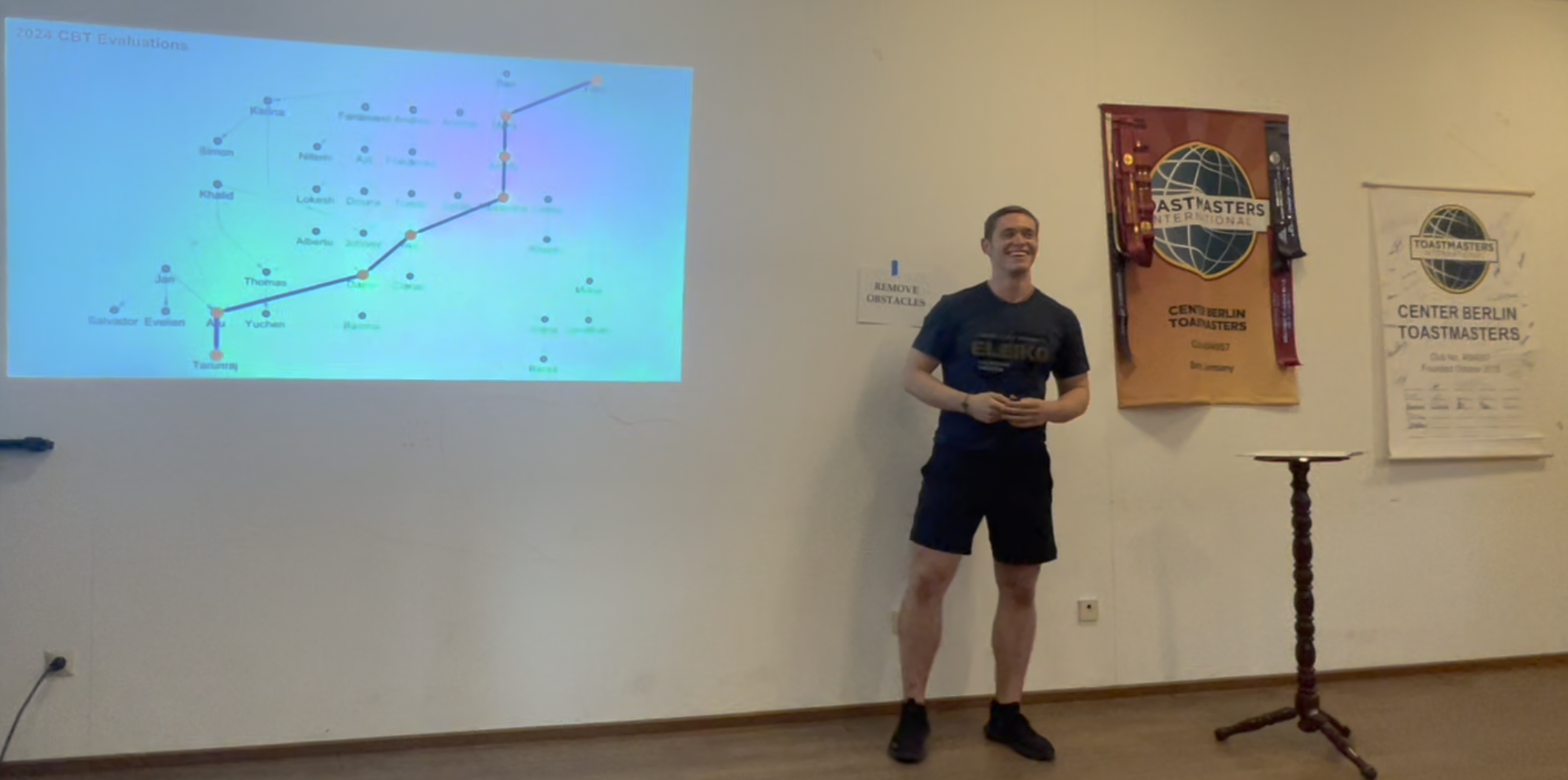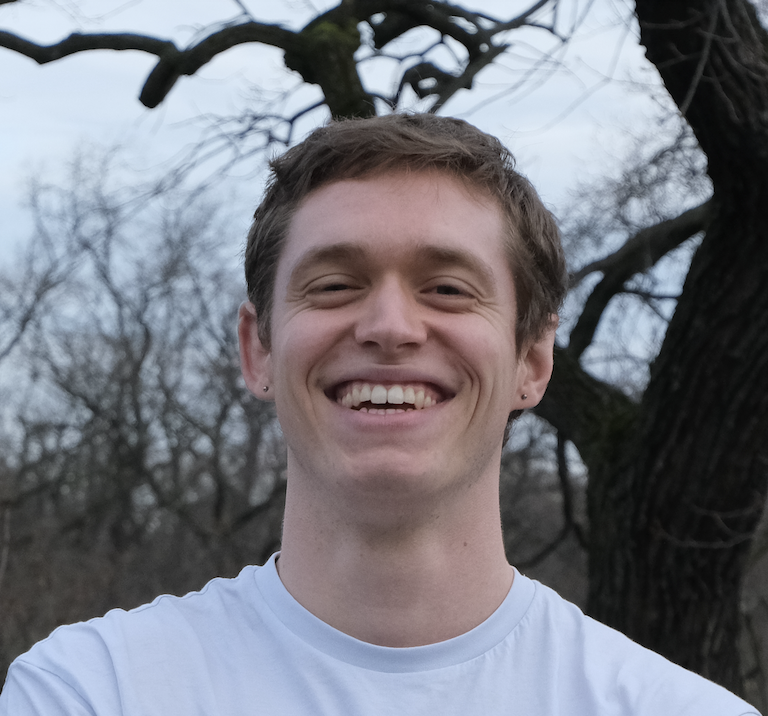Graphing Complexity: The Beauty of Networks 🌐
Published:

5-1 Deliver Your Message With Humor
This project focuses on creating a keynote-length speech that effectively delivers a message and humor to an audience.
Purpose: The purpose of this project is to practice developing and presenting a longer humorous speech.
Overview: Write and present an 18- to 22-minute keynote-style humorous speech. You may choose to use visual aids if they fit your speech and your style. If you receive advanced approval from the vice president education, you may present your speech to a non-Toastmasters audience.
Speech timings: 18:00, 20:00, 22:00
Script
Little Thomas is walking through the local wet market in a city that locals call the Fragrant Harbour, having a look at the squid that has just been fished off the ocean floor. Tall, metallic skyscrapers overlook him. Next to him, on the water, a traditional Chinese junk is showing tourists one of the most famous skylines in Asia. In the background, huge container ships are arriving from all over the world: their horns sounding as they come in and out one of the busiest maritime ports in the world.
If you’re incredibly confused where we are and what I’m doing, then welcome to the world of 3 year-old Thomas. He was catapulted in this huge Asian metropolis, on the other side of the world, that is nicknamed the Pearl of the Orient: Hong Kong. He had just arrived and his parents were taking him on all the most touristy activities they could think of. But Thomas is 3 years old, of course, he is incredibly confused and lost. Nothing makes sense: there are so many different construction noises everywhere around him; different languages being spoken: Cantonese, English, Mandarin, Filipino, Portuguese; trams, buses, subways, overground, taxis and Maseratis are all whizzing past him. 3 year-old Thomas was really wondering where he actually ended up. As time went on, although Thomas got older, and slowly wiser, it was still so hard for him to understand the complexity that the city of Hong Kong was part of. All these different cultures, international corporations, financial institutions and shipping companies. What were they all doing here, on this little island. Why were they here? Why was he here? How did any of this make ANY sense?
The city of Hong Kong is the source of current Thomas’ passion. This passion is called network science: it is the study and understanding of networks. This is what I’d like to share with you today. Hong Kong is a huge port, an airport hub and a financial centre. The city connects families, businesses and governments from all over the world. Hong Kong is a perfect illustration of how interconnected our world is, and how the world is organised in a network structure.
I would like you to hop on board and let me take you on a journey to understanding the complexity of our world through the power and beauty of networks. We will learn what a network is, why it’s important and how studying them can answer some of modern humanity’s questions.
As you can see on the agenda, my speech is 18-22 minutes long. Honestly, when I first saw my next assignment on this dreaded Toastmaster pathway, I thought: “how the hell am I going to fill 20 minutes of speech time?” My first choice was to talk about a topic that has been a loyal and reliable source of content over my past year at Toastmasters. My ex-mother-in-law, or as most of you know her as my ex-girlfriend’s mom or alternatively, my flatmate. It really comes in handy when the mom of your ex-girlfriend isn’t at Toastmasters because she isn’t here to complain or contradict me. But then, I realised I had to move on from this relationship and I couldn’t just keep talking about my ex’s mom. My next best choice would be to share one of my passions: networks.
So what actually is a network? Can anybody shout what they think of when they hear the word network? At its most basic level, a network is a system that connects different things: with nodes and links. Think of shipping routes: ports are the entities or nodes in the network, and the routes that connect these ports are the links between them, just like here. This is what we call a physical network.
So why is viewing systems as networks powerful? First, let me give you an example of how we can view or model information.. Here, at Toastmasters, we have evaluators giving evaluations to speeches. There are different ways to represent this information: agenda, natural language, picture, spreadsheet. But also in a network, with nodes being members and links being evaluations. This is an intangible network, as opposed to the shipping routes we saw earlier. By representing information in a network structure, we can devise mathematical theorems, apply algorithms and modelling to analyse this information in a very different way. Let us extend this evaluator network for all speeches in 2024. Here the structure is seemingly hierarchical. If we extend this to the last year, from June 2023, the network gets more dense.
Through this network of CBT evaluators, I will be introducing some key concepts in network science, what problems they solve and the impact it can have in the real world.
The first is the concept of path-finding. You are trying to find what is the shortest path between two points in a graph. For example, what is the shortest path that you can find to link Felix to Tarun. Here it is. Here it means that Felix gave an evaluation to X, which in turn gave an evaluation to Y and so on, until Tarun. Why is this interesting to know? Well, imagine Felix has some groundbreaking nugget of wisdom he mentioned in his evaluation to Mara. Mara, in turn might have incorporated that knowledge and also mentioned it in her evaluation to Amit. And slowly, this is how this piece of knowledge could have spread, finally, all the way to Tarun. This also applies to shipping routes, where goods need to be transported from one port to another one, on the other side of the world.
The second is community detection. Based on the relations between nodes, and their individual characteristics, you can group nodes into communities. In these networks, the communities are not that obvious. But in the 2024 network, you can see this very separate community here, or the Ferdinand, Felix or Amit Negi community. The separation is not as clear in the 23-24 one, we can see the Jan or Felix one though. When we visualise them a bit differently, it’s a bit easier to make them out. Unfortunately, these communities don’t seem to have that obvious characteristic. Another real-life example, is in social networks on social media. You can group people together based on their friend groups and identify certain groups with specific gender, age and professions.
Third is core components. These are the nodes which have both incoming and outgoing links, meaning they have given and received multiple evaluations in the past year. You could consider these the more active members: they give speeches and evaluations. They are central parts in the CBT network.
Fourth is centrality. We can identify the most important nodes in the network based on how many neighbours they have, how central or important they are in the network. Here, the largest nodes are the ones with the most neighbours, meaning they have given more evaluations or speeches. These are the real drivers of our CBT ™ meetings in the past year. Here, big up to Amit Negi, Iwa and Damir. This can be useful in a transportation network. Knowing which stations are the most important is crucial because if it fails, it may impact the whole network and it’s ability to function.
Fifth, and finally, there is the concept of diffusion. If you remember the concept of path-finding, it could show us how knowledge could be transmitted from Felix to Tarun. This is essentially the idea of diffusion: how information, diseases or technology can spread over a network. For example, take Amit Negi. All of his wisdom and knowledge can only be spread in this sub-network. The other members cannot be reached from him in any way. On the contrary, this is a subset of the network for myself. All the nodes in red are the people I could receive knowledge from. Diffusion is very important when analysing technological adoption in a society or analysing how diseases can spread in a group of people.
To summarise, we have seen different network science concepts. Path-finding finds the most optimal way to traverse a network, community-detection clusters groups of nodes together. Core components identify the central part of a network, Centrality ranks nodes by their importance and diffusion shows us how information can spread in a network.
A model is essentially a simplification of our reality. Networks and graphs are, for me, this perfect model to simplify our world, so we can better analyse it. This is exactly what 3 year-old Thomas would have loved: a simplified version of the world so his little developing brain could better make sense of the absurdity around him.
The following quote by the mathematician John Conway summarises this perfectly:
People think that mathematics is complicated. Mathematics is the simple bit, it’s the stuff we CAN understand. It’s cats that are complicated.
Being able to translate our complex world, cats, into mathematical models like a graph, enables us to then analyse it with sound mathematical tools, computers and modelling techniques. The key part is the initial step, creating an accurate model of our reality. Then, we can use tried and tested mathematical theorems and modelling techniques to analyse these networks.
And this is exactly what I am currently doing in my day job. I do have a life, apart from writing Toastmaster speeches and making stupid jokes! I am developing what is called a Knowledge Graph: a graph representation of the whole economic and business ecosystem. It translates our complex human reality into a language that AI can understand. It can recognise the communities in this ecosystem and the links between companies and people, enabling it to solve a myriad of tasks.
As you might have realised, I am really passionate about network science and modelling the complexity of our world. I have chosen this to be my life calling, at least for the moment. I will be embarking on an exciting journey: pursuing a PhD in Computer Science in Beijing in China, where I will specifically be researching these foundational algorithms in network science that we were talking about just earlier.
I feel like I’ve really come full circle: from little Thomas confused and lost in Hong Kong, not making sense of the world around him. And now, 22 years later, more mature, with a beard, coming back to Asia, this time to Beijing to embark on a journey of research. Research that will help us better understand our modern world and solve all those futile problems that humanity has arbitrarily decided was crucial for our well being. I hope I have been able to share my passion to all of you and who knows, maybe ignited a small spark in you to dig deeper into the beauty of graphs, complexity and networks.
